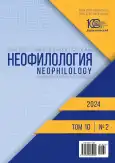The meaning of periphrases in the expression of semantics
- Авторлар: Mardiyev B.K.1
-
Мекемелер:
- Samarkand State University named after Sharof Rashidov
- Шығарылым: Том 10, № 2 (2024)
- Беттер: 537-544
- Бөлім: THEORY AND HISTORY OF CULTURE
- URL: https://journal-vniispk.ru/2587-6953/article/view/295615
- DOI: https://doi.org/10.20310/2587-6953-2024-10-2-537-544
- ID: 295615
Дәйексөз келтіру
Толық мәтін
Аннотация
INTRODUCTION. Periphrasis, which belongs to the linguistic universal that initially interested rhetoricians, is noted in many languages, including Russian and Uzbek. The attention of scientists to the study of periphrastic units, as a rule, is focused on understanding them in the text of a work of art as a stylistic phenomenon. Meanwhile, the linguocultural situation of the formation of periphrastic units is largely due to the anthropocentric orientation. The important role of periphrasis as a unit of speech-cognitive activity, which is reflected in the secondary periphrastic nomination as one of the means of transmitting knowledge about the objects of the surrounding reality, is always associated with the process of repeating thoughts when perceiving a particular object, process or phenomenon, which emphasizes the relevance of the research. Periphrases have an internal syntax, which allows them to be considered in the aspect of grammaticalization involved in the process of human cognition of the world. The purpose of the study is to consider the structuralsemantic organization and grammatical-syntactic structure of sentences that contain periphrastic units. The novelty of the study lies in the attempt to describe the structure of periphrasis in the Uzbek language in the aspect of grammaticalization of periphrastic units.MATERIALS AND METHODS. The method of semantic differentiation was used to analyze examples from modern Uzbek literature and translations of works of Russian writers into the Uzbek language.RESULT AND DISCUSSION. It has been revealed that the structural organization of periphrasis does not occur spontaneously, but on the basis of clearly defined rules.CONCLUSION. The data obtained have theoretical and applied value, since they record periphrases in the texts of writers’ works as a special type of linguistic organization of artistic knowledge, as well as the unification of two scientific directions – the theory of grammaticalization and the theory of periphraseology.
Негізгі сөздер
Авторлар туралы
B. Mardiyev
Samarkand State University named after Sharof Rashidov
Хат алмасуға жауапты Автор.
Email: mardiyevbegali17@gmail.com
ORCID iD: 0009-0000-2680-4769
Cand. Sci. (Philology), Head of Language Teaching Methods Department
15 University Blvd, Samarkand, 140100, Republic of UzbekistanӘдебиет тізімі
- Khasanova M.M. Praktika perevoda perifrazy s nemetskogo yazyka na uzbekskii yazyk (na primere evfe-mizma) [The practice of translating periphrases from German into Uzbek (using the example of euphemism)]. Vestnik nauki i tvorchestva [Bulletin of Science and Creativity], 2018, no. 2 (26), pp. 29-34. (In Russ.) https://elibrary.ru/qomhqt
- Moskvin V.P. O raznovidnostyakh perifrazy [About the varieties of periphrase]. Russkii yazyk v shkole = Rus-sian Language at School, 2001, no. 1, pp. 74-77. (In Russ.) https://elibrary.ru/ugubnj
- Byteva T.I. Ocherki po russkoi perifrastike [Essays on Russian Periphrastics]. Moscow, Elpis Publ., 2008, 302 p. (In Russ.) https://elibrary.ru/quztjp
- Khasanova M.M., Mazhidova M.S. Traktovka, tipologiya i stilisticheskie funktsii perifrazy v stilistike uzbeks-kogo yazyka [Interpretation, typology and stylistic functions of periphrasis in the style of the Uzbek language]. Vestnik nauki i tvorchestva [Bulletin of Science and Creativity], 2018, no. 5 (29), pp. 103-106. (In Russ.) https://elibrary.ru/utowpe
- Du Chunyang. Periphrasis in a poetic text about the moon: W. Stevens “Lunar paraphrase”. Neofilologiya = Neophilology, 2018, vol. 4, no. 16, pp. 26-31. (In Russ.) https://doi.org/10.20310/2587-6953-2018-4-16-26-31, https://elibrary.ru/yqhyrf
- Du Chunyang. Celestial objects periphrastic naming and synonym correlation. Neofilologiya = Neophilology, 2020, vol. 6, no. 21, pp. 34-40. (In Russ.) https://doi.org/10.20310/2587-6953-2020-6-21-34-40, https://elibrary.ru/ynazwp
- Shcherbak A.S. Perifraza «tatarskii murza» i antroponim Derzhavina [Periphrase “Tatar Murza” and Derz-havin’s anthroponym]. Imya v prostranstve kul’tury [Name in the Cultural Space]. Voronezh, SC “Voronezh Regional Printing House”, 2023, pp. 331-338. (In Russ.) https://elibrary.ru/tkvsnx
- Mezhueva O.V., Shcherbak A.S. Regional nicknames: secondary nomination. Vestnik Tambovskogo universite-ta. Seriya: Gumanitarnye nauki = Tambov University Review: Series Humanities, 2010, no. 10 (90), pp. 150-154. (In Russ.) https://elibrary.ru/mvztuh
- Khasanova M.M. O problemakh vossozdaniya obraznosti v perevode perifrazy [On the problems of recreating imagery in the translation of periphrases]. Molodoi uchenyi = Young Scientist, 2017, no. 20 (154), pp. 502-504. (In Russ.) https://elibrary.ru/ypeeql
- Aliyari Shorekhdeli M., Parvezi Mogadam E. Analysis of the equivalence of Russian periphrases in the Persian language. Prepodavatel’ XXI vek [Lecturer at 21st Century], 2021, no. 3-2, pp. 400-406. (In Russ.) https://doi.org/10.31862/2073-9613-2021-3-400-406, https://elibrary.ru/krfojf
- Melikyan V.Yu., Melikyan A.V. Fixed phrase schemes as the “results” of grammaticalization process. Voprosy kognitivnoi lingvistiki = Issues of Cognitive Linguistics, 2022, no. 4, pp. 102-114. (In Russ.) https://doi.org/10.20916/1812-3228-2022-4-102-114, https://elibrary.ru/nmpwxc
- Melikyan V.Yu., Melikyan A.V., Posidelova V.V. Construction grammar vs syntactic phraseology. Voprosy kognitivnoi lingvistiki = Issues of Cognitive Linguistics, 2021, no. 2. pp. 46-64. (In Russ.) https://doi.org/10.20916/1812-3228-2021-2-46-64, https://elibrary.ru/ixddpw
- Kravtsov S.M., Maksimets S.V., Chernositova T.L. Interlingual semantic correspondences through the prism of national and cultural identity of the ethnic community. Izvestiya Yuzhnogo federal’nogo universiteta. Filologi-cheskie nauki = Proceedings of Southern Federal University. Philology, 2020, no. 4, pp. 29-36. (In Russ.) https://doi.org/10.18522/1995-0640-2020-4-29-36, https://elibrary.ru/carlfh
- Kravtsova M.N. Phraseological unit and periphrasis: concerning the problem of linguistic status correlation. Vestnik Krasnoyarskogo gosudarstvennogo pedagogicheskogo universiteta im. V.P. Astaf’eva = Bulletin of Krasnoyarsk State Pedagogical University named after V.P. Astafyev, 2013, no. 2 (24), pp. 236-239. (In Russ.) https://elibrary.ru/qcecuz
- Dortsueva N.I. Periphrases and phraseological units in the tasks of the Russian language Olympiad. Russkii yazyk i literatura v shkolakh Kyrgyzstana [Russian language and literature in schools of Kyrgyzstan], 2018, no. 4, pp. 21-28. (In Russ.) https://elibrary.ru/qqlmcp
- Grekhneva L.V. Implementation of the functionality of periphrasis in language and speech. Litera, 2021, no. 2, pp. 53-60. (In Russ.) https://doi.org/10.25136/2409-8698.2021.2.34947, https://elibrary.ru/kxfxkq
Қосымша файлдар










